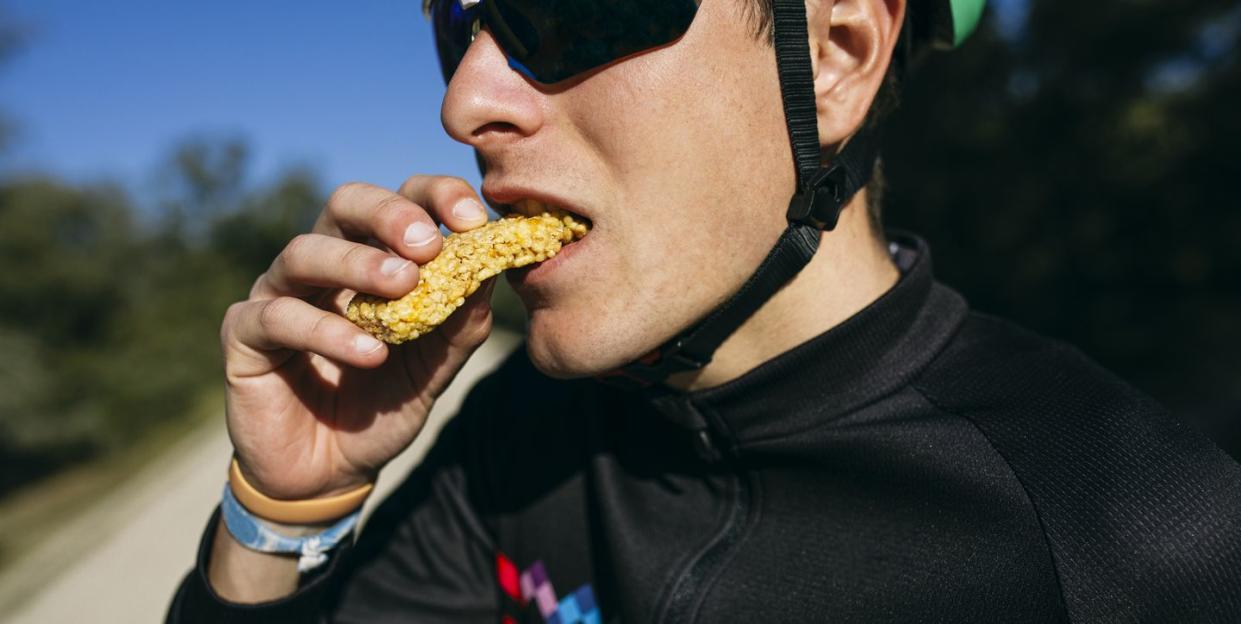Low-Carb Is the Diet Du Jour, But Here Are 5 Legit Reasons Why We Need Carbs

Popular diets are a bit like the Dow Jones: A tip on a hot item sends everyone flocking to get in on the action. Then it cools, something else gets hot, and the market corrects itself before swinging in another direction. We saw it with the low-fat craze. Then everyone leaped aboard the low-carb bandwagon.
Now, it’s time for another market correction, because too many well-intentioned active people are stressing their bodies and wrecking their workouts and recovery by skimping on this essential macronutrient.
We’re not talking about going back to the days when you chased a heaping plate of spaghetti with a few dinner rolls because you had a 50-mile ride the next day. That was overkill. And we’re also not saying that certain low-carb diets don’t work. We know many fat-adapted athletes who have found low-carb options that work for them. Instead, we mean eating healthy carbs in a balanced way that gives your body all the nutrients it needs to perform.
“Glucose from carbohydrates is the fuel your brain uses to produce energy,” says nutrition and fitness coach Rick Kattouf, O.D., founder of TeamKattouf coaching in Greenville, South Carolina. “It’s also your body’s preferred fuel source for exercise, especially if you want to ride hard and fast or for long distances.”
Iñigo San Millán, Ph.D., of the University of Colorado Sports Medicine and Performance Center in Boulder, puts it this way: “Glycogen is gold, and you need carbohydrates for optimum glycogen storage.”
Here’s what they’d both like you to know about carbs:
Carbs Burn Fat.
Carbohydrates not only provide fuel for your hard-working muscles, but they also enable fat metabolism. “Always keep in mind that fat burns in a carbohydrate flame,” Kattouf says. The process your body uses to convert fat molecules into energy for burning requires glycogen. If you have no stored carbs on board, it will dive into your protein (a.k.a. your muscle tissue) to make a glucose in a process called gluconeogenesis. It’s better to fuel your body—and your rides—with carbohydrates than to essentially force your body to, as San Millán puts it “eat itself to fuel itself.”
Carbs Help Regulate Muscle Contraction.
Glycogen, which again is stored carbohydrates, also regulates muscle calcium function, which you need for muscle contraction. So when glycogen/glucose levels decline, so does your power output, San Millán says.
Carb-Cutting Weight Loss Is Often Temporary (and Mostly Water.)
People lose weight quickly when they cut out carbs, but it’s mostly water weight. Each gram of carbohydrate stores with three to four grams of water. When you shed the carbs, the water is squeezed out of your muscles as well as your liver—so you lose pounds of water weight, but not fat.
Overtime, a diet lower in carbs could lead to long-term weight loss, but what’s important there is that it is a diet you can sustain over a long period of time, which might be lower in carbs but not zero-carb. “Depriving your brain of carbs and sugar [often] leads to binging and out-of-control cheat days,” Kattouf says. “[When carbs are reintroduced,] people inevitably gain all the weight back and then some.”
Vegetables Alone Don’t Cut It.
Yes, you can get some carbohydrates from vegetables, but they are not a good carb source. “You need vegetables to feed your body healthy nutrients, but they’re not sufficient for fueling your body,” Kattouf says. “Someone will say, ‘I ate my broccoli, so I’m good,’ but they don’t realize that there are only 5.8 grams of carbohydrates in a cup of broccoli. That would be like eating a slice of whole grain bread for your protein. Yes, it has a few grams of protein, but it’s not enough to serve your needs.”
It’s better to eat the bread, the pasta, the rice, the quinoa, the potatoes to load and reload your liver and muscle glycogen stores to fuel your rides. Plus, there are simple ways to make your meals vegetable heavy, but also include healthy carbs, like adding roasted sweet potato to a greens-based, veggie-filled salad.
The More You Move, the More You Need.
How much carbohydrate you need depends on your activity level. When you’re not riding a lot, you don’t need much. When you’re putting in miles, you need more. The following chart can help you plan your fueling. (Each gram of carbohydrate provides four calories of energy.)
Recommended Daily Carbohydrate Based on Exercise Level:
Low (<1 hour a day) = 1.5 to 2.5 grams per lb. of body weight
Moderate (~1 hour/day) = 2.3 to 3.2 g/lb.
Active (1 to 3 hours/day) = 2.5 to 4.5 g/lb.
High Active (>4 to 5 hours/day) = 3.5 to 5.5 g/lb.
If you still want to be conscious of your carb intake, focus on less-processed, whole grain carbs when you’re not training. Good options include brown rice, whole grain or spouted breads, sweet potatoes, quinoa, oatmeal, bananas, and chickpeas.
Before a race or long ride, you want to focus on fast-digesting carbs with less fiber as to avoid any gastrointestinal issues during exercise. Sometimes, this means the carb choice may be slightly more processed like white bread or white rice, but also includes bananas, white potatoes without the skin, sweet potatoes without the skin, or English muffins.
Overall, you want to be conscious of your added sugar consumption as it pertains to carbs. Sticking to whole food options is one of the easiest ways to limit added sugars. But there’s nothing wrong with enjoying a chocolate chip cookie at the end of a long ride.
You Might Also Like

